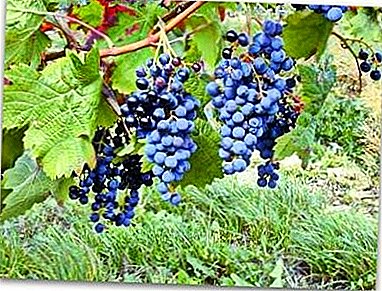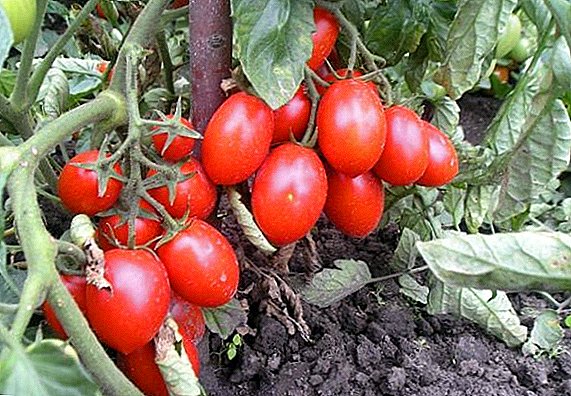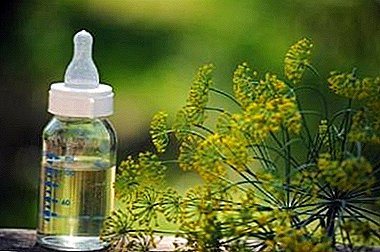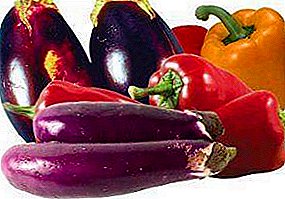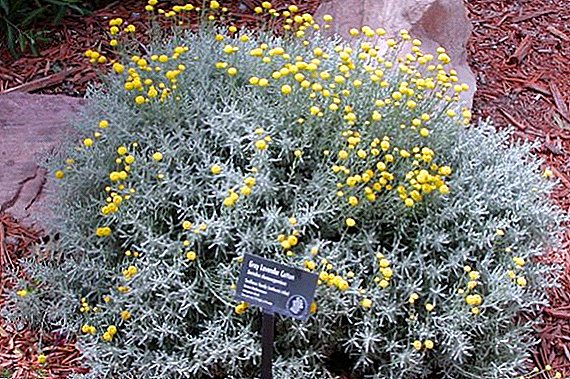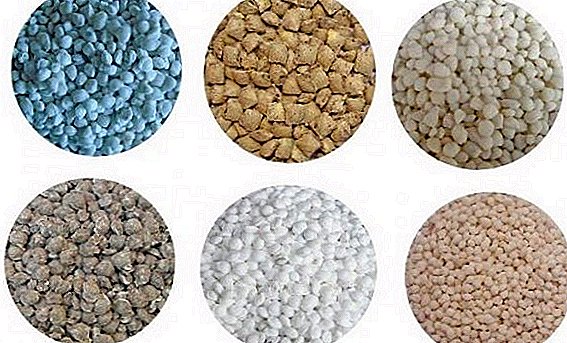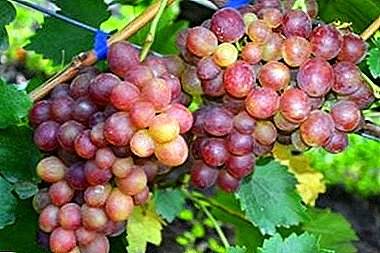
This very young variety was created, it seems, especially for those who like sweeter ones.
To many, its taste seems overly cloying, but gourmets argue that it is generally the standard of grape flavor.
Berries these are sweetthat it is enough to try only one to make sure that neither lemonade, nor ice cream, nor the most expensive desserts can replace the Rosemus grape in summer. In this article, there is all the information about the grapes "Rosemus", including a description of the variety and photos.
Grapes Rosmus: description of the variety
Rosemus - table hybrid subspecies of pink grapes. The term of ripening is super early. Amethyst, Amirkhan and Anyuta also belong to superearmed varieties.
Berry ripens already in early August, but on the bushes it persists until mid-autumn - for better sugar. Nevertheless, despite the stability, it is better not to leave Rosemus on the bushes longer than the first days of October - otherwise the nutmeg may deteriorate.
 It has a high demand from buyers wishing to purchase both berries and cuttings. Very well tolerated transportation, does not rot, well and is stored for a long time. Berries do not crack and do not spoil.
It has a high demand from buyers wishing to purchase both berries and cuttings. Very well tolerated transportation, does not rot, well and is stored for a long time. Berries do not crack and do not spoil.
Nadezhda Azos, Bazhena and Krasa Beams are also well preserved during transportation.
The most popular fresh for its unusually sweet taste with a vibrant nutmeg and pink aftertaste. Also used in homemade desserts and bouquets of muscat dessert wines.
Rosemus - The young variety and its characteristics are currently being tested. The preliminary conclusions are as follows: the variety is not afraid of either mealy dew (mildew and oidium), or gray rot, or parasites. Osami is slightly damaged.
Whether phylloxera is afraid is not yet established. Sugar content - over 20 Brix. Needs a standard pruning of six to eight eyes at a rate per bush of 35.
Such varieties as Aladdin, Delight White and King Ruby are also high in sugar.
A photo
"Rosemus" grapes photo:





Appearance
Bushes differ in high force of growth. The cluster is large, up to a kilogram in weight, tapered, not prone to peas.
The same sign is different Pereyaslavskaya Rada, Ruslan and Charlie.
Berries large, 10-12 g, oval, color - from pinkish-golden to saturated pink. The flesh is juicy, fleshy. The skin is dense, of moderate thickness, not eaten when eaten.
During the growing season, three inflorescences are usually formed on the shoot. The matured shoot is greenish-brown, covered with dark ruby knots. Hermaphrodite flowers.
Montepulciano, Julian and Hadji Murat also possess hermaphroditic flowers.
Leaves dark green, medium size, round, medium cut. The stem is dense, long, light green.
Breeding history
Rozmus is the fruit of the works of Ukrainian amateur breeder Vitaly Zagorulko.
"Dad and Mom" - varieties of Arcadia and Sofia. The variety was obtained as a result of the so-called saturating selection, when the previous variety was crossed with the sweeter, because the percentage of sugar content at Rosemus often exceeds even its “ancestor” - radiant Kishmish.
It quickly spread throughout the southern regions, suitability for growing in colder latitudes is currently being tested.
Diseases and pests
All scientists would like to invent a variety that the birds would not touch. Alas, while it was not possible to anyone - jays, sparrows, tits, magpies will surely come.
Protect grapes from the attack from the air is easy - here will help a solid mesh barrier with small cells. Do not use fishing nets for this type of fish - nothing good will come of this, except for those trapped and dead birds that have decided to eat berries at an unkind hour.
 Do not believe gardeners, praising scarecrows and all sorts of posters and balls with the menacing eyes of kites and peregrine falcons - birdies are not at all afraid of them.
Do not believe gardeners, praising scarecrows and all sorts of posters and balls with the menacing eyes of kites and peregrine falcons - birdies are not at all afraid of them.
With wasps harder. Some gardeners argue that the striped predator Rosmus uneasy, others just insist that he is powerless against them. Therefore clusters will need to be wrapped in special small-mesh bags.
They will give the berry to breathe air and sunshine, but will not let the wasp. Sticky traps, insecticides like "OtOs". It will be necessary to comb the area on the subject of wasp nests, and all that exists - to destroy. You also need to seal the holes in the pillars that hold the bushes - this is the favorite place of settlement wasps.
Phylloxera - perhaps the most terrible enemy of grapes and the worst thing is that it is very difficult to get rid of it. Only volatile carbon disulfide helps.
The concentration should be approximately 300-400 (but not less than 80) cubic centimeters per square meter. Only in this way it will be possible to save the bush from the parasite, the low dose will be simply useless.
Another unpleasant affliction - bacterial cancer. Scientists declare that they have already invented means to guarantee a full recovery to the diseased bush, but so far they are at the experimental stage. Therefore, it is necessary to strengthen preventive measures.
Before the purchase seedlings need very carefully inspect for their integrity, and afterwards it is better not to injure and scratch the cuttings once again. Indeed, from the very rubbish scratches can develop a tumor. The diseased parts of the vineyard are bred and burned.
Do not neglect the prevention of such common grape diseases as anthracnose, bacteriosis, chlorosis, and rubella.
Rosemus a very young variety and still gaining a reputation for itself, but judging by the preliminary reviews, it has a great future.
He is not afraid of frostand it will be necessary to protect it from exactly the same thing that all the winegrowers protect from their vines - from birds, wasps, aphids. It is not difficult at all, especially when you know that in return you will receive such a surprisingly sweet southern miracle, which even the most expensive delicacy cannot compare with.


